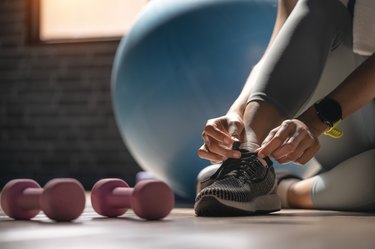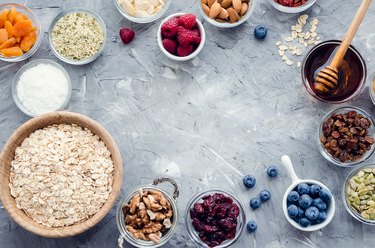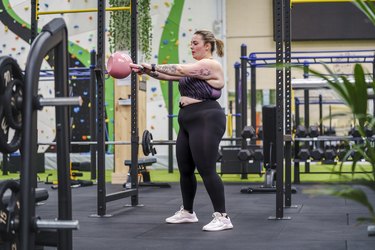
When trying to transform your body, you may end up finding you're building muscle but not losing weight. If weight loss is one of your goals, this can be a frustrating situation.
Here's why this happens, what you should know about how to gain muscle and lose fat and tips for how to exercise and eat to help you achieve your goals.
Video of the Day
Video of the Day
Weight Loss vs. Fat Loss
The first thing you need to know is that weight loss and fat loss are not the same thing. You can be losing fat but not losing weight, especially if you are consistently building muscle through resistance training, says Charlotte Dennis, CPT, certified personal trainer and founder of Lifted with Lottie.
"When someone focuses on building muscle, this will reduce body fat and create lean muscle mass," Dennis says, resulting in an overall leaner body composition. The number on the scale may not go down, though, because muscle is denser than fat — meaning it takes up less space but also weighs more.
A weight-loss plan shouldn't mean following a very low-calorie diet or doing excessive cardio to see quick results. That could lead to losing muscle instead of fat, which may cause the scale to go down initially, but your body will be less muscular than you may have hoped, per the Cleveland Clinic.
What's more, losing weight too quickly can slow down your metabolism, which may make weight loss more challenging and even result in weight gain in the long run.
When it comes to sustainable weight loss, slow and steady wins the race. The experts at the University of Rochester Medical Center recommend losing no more than 1/2 to 2 pounds per week.
Can You Lose Fat and Gain Muscle at the Same Time?
The process of building muscle requires fuel — excess fuel in the form of calories from food, per the Cleveland Clinic. This means you need to eat more than you burn through daily activity, including your workouts, if you want to gain muscle mass.
On the other hand, weight loss usually requires you to burn more calories than you take in. So, if you have goals of both losing weight and gaining lean muscle, you can see how they might contradict one another.
However, you can lose fat and gain muscle at the same time, especially if you do strength training, says Kristina Centenari, CPT, certified personal trainer and Tonal coach.
If you're building muscle but not losing weight, then your body is undergoing a process commonly known as body recomposition.
What Is Body Recomposition?
"Body recomposition entails building muscle while losing fat through diet and strength training," Centenari says. "It's a great way to approach one's fitness journey, as the goal is to maintain strength and function, while achieving your desired aesthetic goals as well."
The body doesn't turn fat into muscle, but strength training can help you reduce your body fat while increasing your lean muscle tissue at the same time.
"Depending on the way in which he or she is training and eating, building muscle while losing fat can absolutely aid in overall weight loss," Centenari explains. "The more muscle someone has, the more calories they burn throughout the day."
It's important to note, though, that the scale isn't always the best indicator of your progress when you're going through body recomposition, Centenari says.
How to Track Your Progress Without a Scale
During body recomposition, it's vital to remember that gaining muscle could mean gaining weight on the scale, and that the scale is a very narrow and limited predictor of success.
"Muscle weighs more than fat, so it is possible to see the number on the scale go up if you're also gaining muscle. This is why the scale can be misleading," Centenari says.
Instead, she suggests looking to non-scale indicators of progress like how your clothes fit, your energy levels and mood or if you're able to lift heavier at the gym.
You can also track changes in your body measurements and body fat percentage.
How to Exercise to Gain Muscle and Lose Fat
The National Academy of Sports Medicine (NASM) says that muscle gain is typically a slower process than weight loss. Still, if you are experiencing a weight-loss plateau, it's possible that muscle gain could be the culprit.
Effective training to lose fat and build muscle includes strength training along with specific types of cardiovascular activity that can support your goals.
"While cardio is also a must for the health of our heart and other internal processes, strength training is the winner for building and maintaining muscle — especially crucial for our body's longevity as we begin to age," Centenari says.
Strength Training
Your strength training regimen should include two to six sets of six to 12 repetitions of an exercise.
When it comes to results, being consistent is essential. Aim for three to five days of strength training sessions per week, being sure to give each muscle group 24 hours minimum rest in between sessions. (If you're a beginner, start with three days at most, and space them out throughout the week so you don't overdo it.)
You can increase calorie burn during your strength-training routine by selecting exercises that burn a maximum amount of calories. For example, ACE recommends choosing compound exercises that incorporate all of your large muscle groups such as bench press, deadlift, barbell rows, squats and overhead press.
These exercises require the activation of your entire body, leading to more calories burned during your workout.
Keeping rest times to a minimum and incorporating a circuit-training style in which you move from one exercise to the next to keep your heart rate up will also help you burn more calories during your training sessions.
Cardio Exercise
When it comes to cardio, choosing high-intensity exercise (or high-intensity interval training, aka HIIT) can help increase levels of a hormone called human growth hormone, which stimulates muscle growth and fat burning alike, according to Colorado State University.
Growth hormone increases fat metabolism, so fat is used for energy instead of being stored. The hormone also helps you repair and build muscle. And as we've noted, the more muscle you have, the more calories your body naturally burns, which helps with weight loss and maintenance over time.
Exercise of any type can stimulate growth hormone, but HIIT elevates muscle-building and fat-burning hormones substantially with only a short workout. And research shows it's an effective way to burn fat and lose weight, according to a February 2018 review of 39 studies in Sports Medicine.
HIIT involves alternating short bursts of intense exercise (like sprinting, push-ups or burpees) with lower-intensity recovery periods (say, 30 seconds of exercise followed by 30 seconds of rest).
The Mayo Clinic recommends doing 15 minutes of HIIT three days per week.
How to Eat to Gain Muscle and Lose Fat
Nutrition plays a significant role in your ability to burn fat and gain muscle, says Crystal Scott, RD, a dietitian at Top Nutrition Coaching. It can be challenging because a caloric surplus is needed to build muscle and a caloric deficit is necessary to lose fat, but there are strategies you can adopt to accomplish both at once.
"It is possible when someone is in a calorie deficit while also following a weight-training program," Scott says.
Prioritize Protein
Research suggests it's possible to achieve body recomposition by following a balanced diet and strength-training program. A February 2018 study in the Journal of the International Society of Sports Nutrition found that women who followed a strength-training program while consuming a high-protein diet experienced significant fat loss and increased muscle mass.
Furthermore, in a May 2017 article in Advances in Nutrition, researchers stress that losing weight through dieting leads to a loss of muscle mass but that increasing protein amounts helps to prevent this effect, preserving your muscle while losing fat.
To lose fat and build muscle, then, you should eat foods rich in protein. In particular, increasing the amount of protein you eat can help you reach your goals.
"Adequate protein intake is essential for muscle growth and repair, while consuming fewer calories than the body burns can lead to weight loss," Scott says.
To calculate how much protein you should aim to eat per day, Scott recommends 1.6 to 2.4 grams per kilograms of body weight. (For comparison's sake, the general recommendation for someone looking to maintain their weight is 0.8 grams per kilogram.)
Keep in mind that 1 kilogram equals about 2.2 pounds. So, for example, if you weigh 180 pounds, that's about 82 kilograms (180 divided by 2.2). If you multiply that by 1.6, that means you should be aiming to eat a minimum of 131 grams of protein per day.
Nutritious foods high in protein include:
- Meats like chicken, turkey, lean pork and lean beef
- Fish like salmon and tuna
- Plant-based proteins like tofu and tempeh
- Lentils and beans
- Yogurt and cottage cheese
- Eggs
Don't Cut Calories Too Low
Careful maintenance of calorie intake that supports your body weight, activity level and needs while creating a small deficit through diet and activity level will increase your chances of being able to build muscle and lose fat, per ACE.
With that in mind, don't try to slash calories too low to achieve quick weight loss. Rather, stick to a small caloric deficit — a couple hundred calories a day or so — to support your training and achieve slow-and-steady weight loss.
To do that, you'll first need to get an idea of how many calories you need to maintain your current weight. You can do so by downloading a calorie-counting app or using an online calculator, such as the Mayo Clinic's Calorie Calculator.
To give you a rough estimate, the Dietary Guidelines for Americans recommend active adults get somewhere between 2,000 and 2,400 calories per day, depending on body size and composition.
Strategies you can use to make sure you're meeting your calorie and nutrition needs include:
- Tracking food intake using a food diary or mobile app to make sure you're consuming the right amount of macronutrients and micronutrients
- Planning meals in advance to ensure they are balanced and meet your nutritional needs
- Choosing nutrient-dense foods, such as fruits, vegetables, lean proteins and whole grains
- Eating slowly and mindfully to avoid overeating
- Minimizing highly processed and calorie-dense foods
- Drinking plenty of water
- Cleveland Clinic: "The Very Best Way to Lose Weight & Keep It Off"
- University of Rochester Medical Center: "Maintaining Weight Loss"
- Mayo Clinic: "Strength Training: Get Stronger, Leaner, Healthier"
- NASM: "5 Fitness Myths-Busted!"
- Lipids in Health and Disease: "Effects of High-Intensity Circuit Training, Low-Intensity Circuit Training and Endurance Training on Blood Pressure and Lipoproteins in Middle-Aged Overweight Men"
- Colorado State University: "Growth Hormone (Somatotropin)"
- International Journal of Medical Research & Health Sciences: "Effects of High Intensity Interval Training on Plasma Levels of GH and IGF-I"
- Journal of the International Society of Sports Nutrition: "International Society of Sports Nutrition Position Stand: Diets and Body Composition"
- Advances in Nutrition: "Preserving Healthy Muscle During Weight Loss"
- Perspectives on Psychological Science: "Reducing Calorie Intake May Not Help You Lose Body Weight"
- ACE: "5 Weight-loss Lies We Tell Ourselves"
- ACE: "Daily Caloric Needs Estimator"
- ACE: "Physical Activity Calorie Calculator"
- Mayo Clinic: "Infographic: High Intensity Interval Training (HIIT)"
- Sports Medicine: "Effect of High-Intensity Interval Training on Total, Abdominal and Visceral Fat Mass: A Meta-Analysis"
- Dietary Guidelines for Americans, 2020-2025






